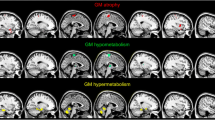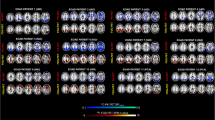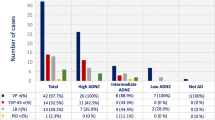Summary.
Neuropathological studies in Alzheimer's disease (AD) indicate specific loss of layer III and V large pyramidal neurons in association cortex. These neurons give rise to long cortico-cortical connections, projecting through the corpus callosum, in an anterior-posterior topology.
Based on these findings we hypothesized that regional corpus callosum atrophy may be a potential in vivo marker for neocortical neuronal loss in AD.
To evaluate this hypothesis, we developed a method to measure cross-sectional area of the corpus callosum and of five corpus callosum subregions on midsagittal magnetic resonance imaging scans (MRI). In a subsequent series of six experimental studies using MRI, 18FDG-PET and EEG, we investigated the relation of white matter hyperintensities (WMH) to corpus callosum size and correlated regional pattern of corpus callosum atrophy with regional cortical metabolic decline as well as intracortical coherencies.
Mean total corpus callosum area was reduced significantly in AD patients compared to healthy age-matched controls, with the greatest changes in the rostrum and the splenium and relative sparing of the truncus. The regional pattern of corpus callosum atrophy was independent of WMH load and correlated significantly with pattern of regional metabolic decline measured with 18FDG-PET, the degree of cognitive impairment and regional decline of bilateral intracortical-coherency in EEG in AD patients. We further found that hippocampus atrophy, as a marker of early allocortical degeneration, was more pronounced than total corpus callosum atrophy in mild stages of AD. Regional corpus callosum atrophy in mild disease, however, suggested early neocortical degeneration in AD. In a longitudinal study, AD patients showed significantly greater rates of corpus callosum atrophy than controls. Rates of atrophy correlated with progression of clinical dementia severity in AD.
Our results indicate that regional corpus callosum atrophy in AD patients represents the loss of callosal efferent neurons in corresponding regions of the neocortex. As these neurons are a subset of cortico-cortical projecting neurons, region-specific corpus callosum atrophy may serve as a marker of progressive neocortical disconnection in AD.
In combination with measurement of hippocampal atrophy, assessment of corpus callosum atrophy over time in individual patients is useful to evaluate effects on brain structure of currently developed drugs, thought to slow or modify AD progression.
Similar content being viewed by others
Author information
Authors and Affiliations
Additional information
Received November 26, 2001; accepted January 8, 2002
Rights and permissions
About this article
Cite this article
Hampel, H., Teipel, S., Alexander, G. et al. In vivo imaging of region and cell type specific neocortical neurodegeneration in Alzheimer's disease . J Neural Transm 109, 837–855 (2002). https://doi.org/10.1007/s007020200069
Issue Date:
DOI: https://doi.org/10.1007/s007020200069




